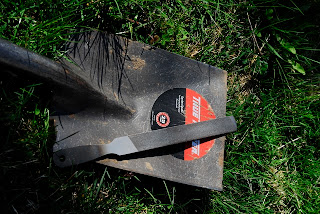Since many of us aren't quite ready to be working in the garden, I thought this may be the time to talk about keeping our tools in "good as new" condition.
I believe it is safe to say that each of us has a least one person in the household who just doesn't manage to get the tools cleaned and safely stowed from one season to the next, let alone honed. I was reminded of this when I attempted to push a spade into the one of the raised beds to remove the sod. It couldn't cut through a single blade of grass, as hard as I tried, that spade would not dig into the sod. It is not surprising however since it's edge has never been sharpened.
Now left with two options, purchase a new spade for myself, or sharpen the one we already have. Since I am not one to buy anything to replace something readily available it made more sense to purchase a rasp.
Sharpening a spade is a simple chore. A few minutes with a rasp restores the "good as new" to the spade's edge. Begin by cleaning the spade. A quick brushing will remove any left over soil clinging to the metal, then, using a medium rasp (file), slide the file in one movement, from one end of the spades edge to the other and also away from the edge. Repeat this a few times on both the front and back sides of the spade.
Give the spade a quick wipe-down and it is ready to for work.
All your gardening tools should be cleaned and dried well at the end of the season and stored in a safe, dry place.
.jpg) s
s
This rasp is light weight and easy to use.
Glide the rasp along the edge of the spade from one end to the other and away from you at the same time.
My favorite gardening tool is without doubt the garden weasel. I love this tool. It cultivates to loosen the soil or to remove weeds. Flip it over and use it to push and pull soil as with a hoe. Keeping it clean with a quick hosing down after each use will extend the life of your weasel.
Garden Weasel
Rinse after each use and allow to air dry.
My weasel is several years old and still looks and works like new. With care all your tools will continue to look and function like new and will save $$$ over the years.
.jpg)
Next is my garden fork, it's great for removing things like straw and hay from the chicken run, or for breaking up soil, etc.
When/if tiny rust spots appear sand them off immediately and touch up the area with a thin rubbing on of oil.
.
.jpg)
.jpg)



.jpg)
.jpg)

.jpg) s
s .jpg)


.jpg)
